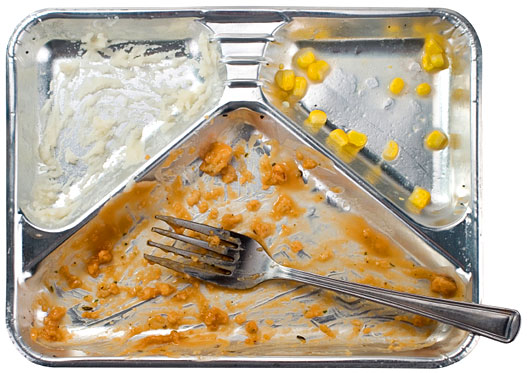The United States imprisons more people than any other country. In fact, in 2014, over 1.5 million people sat in federal and state prisons. So, it’s no wonder states struggles to cover costs to maintain prisons and prisoners. That’s why states started privatizing prison food service to cut costs.
Aramark
One of the most well-known private outsourcer companies, Aramark, holds multi-million dollar contracts with a handful of states and a handful of countries overseas. Aramark provides food, clothing, commissary goods, and similar things to over 600 correctional facilities at a cheap price (some states saving as much as $14 million per year). But is cheaper better?

Gif courtesy of Yosub Kim via Giphy.
In 2009, Kentucky Northpoint prisoners started a riot over Aramark’s food in which several buildings burned irreparably. Still, just a few years later in 2013, Michigan signed a 3-year, $145 million contract with the same company to provide the same service, promising things have changed. They didn’t.

Gif courtesy of Youtube via Giphy.
In the years following the signing, the American Civil Liberties Union found Aramark in violation of shorting inmates food, having unsanitary cooking and serving areas, and serving food contaminated by maggots and mice. Aramark “knowingly served rotten meat, ordered inmates to serve food pulled from the garbage, handed out food on which rats nibbled, and served moldy food,” according to this article found on the Michigan House of Representatives website.
Besides serving tainted food, Aramark employees were found smuggling drugs and other contraband inside, engaging in sexual acts, and even working as hired hit men, and that’s just in Michigan.

Gif courtesy of Yosub Kim via Giphy.
Aramark was fined a meager $86,000 (for making unauthorized meal substitutions and not preparing the correct number of meals), dust compared to their big $48.3 million/year payout. Aramark was never forced to pay this, but was later charged $200,000.
Michigan ended up terminating their contract with Aramark in 2015, 18 months before their contract expired. Aramark didn’t blink an eye, considering they overbilled Michigan, Kentucky, and Pennsylvania, to name a few (just the taxpayers dime). It’s no wonder that in 2014 private correctional facilities became a $4.8 billion industry.
Commissary
Aramark is responsible for food shortages, contaminated food, and many other horrendous health violation, so it’s no wonder why prisoners turn to commissary to fill their stomachs. But, the same company practically starving prisoners is the one providing goods in commissary.

Photo courtesy of giphy.com
Yes, prisoners are forced to buy food (and other supplies) from the same company depriving them. The matter of the fact is prisoners are trying to buy toothpaste and toilet paper AND feed themselves on the salary of a prison job that only pays around $25 a month. Since money is prohibited and cigarettes were banned in penitentiaries, commissary goods have become currency in prison, mackerel and stamps being the most common form of moolah amongst those serving time.
At some penitentiaries, commissary goods are sold at a lower price than they would be in stores. This might be why it’s easy for prisoners to make concoctions likes Oreo cookie cake, sweet and sour pork, cheesy noodles, and even tamales. However, these recipes are a lot different from how you make it at home. The main base to any recipe usually starts with Maruchan ramen noodles; just take a look at this prisoner’s cookbook and see for yourself. You can even find a few others at your closest Barnes and Noble, or you can pre-order rapper Prodigy’s book about food behind bars set to release this October.

Photo courtey of takingarideintheawkwardmobile.tumblr.com
“Cadillac,” a cup of coffee with a packet of hot chocolate added to it, sounds like a shabby way to make a mocha coffee, but it’s the norm here. Cheese sauce is pretty easy to make: mix boiling water with crumbled nacho cheese Doritos. These are just a few recipes in the Jail House Recipes Cookbook. You even start to miss chicken nuggets being on the inside, but prisoner’s make a “similar” version by wrapping ramen noodle mush around summer sausage and cooking the nuggets in the microwave until they’re brown.
Among the most coveted recipes in prison might be “Pruno.” Pruno, aka prison wine, is made by fermenting fruit, fruit cocktail, sugar cubes, ketchup, and slices of bread (yeast) together in a warm bag. Prisoners beat all the ingredients together into a pulp. After a week, the mixture is ready to drink. Mmmmm.

Photo courtesy of nicolegary.tumblr.com
Nutraloaf
Prison food is no joke, and with almost no regulation – inhumane. Nutraloaf, aka disciplinary loaf or “the loaf,” is given to inmates who act out or misbehave. Like in Orange is the New Black, inmates are given “the loaf” in the shu. Nutraloaf can be made multiple ways. According to NPR, Pennsylvania makes it with potatoes, cabbage, and margarine, but in some states, dinner from the day before is just thrown together and baked; it’s considered nutritionally complete since it includes the prison’s required number of calories.
Prisoners are usually fed nutraloaf days, sometimes weeks, at a time for every meal. Jeff Ruby, dining critic, described nutraloaf as tasting “neutral” and being a “thick, pulpy aftermath of something you dissected in biology class: so intrinsically disagreeable that [his] throat nearly closed up reflexively.” See for yourself just how gross “the loaf” is.
Using food as punishment seems unethical, which is why critics of nutraloaf call it cruel and unusual punishment. In December of 2015, New York decided to end the use of nutraloaf in its’ state prisons, but hundreds of other prisons around the country still continue to serve nutraloaf to unruly prisoners. It remains legal since there is no law stating prison food must be “aesthetically pleasing.”
If you’ve learned one thing here, it’s that prison food is disgusting, making it impossible to stay healthy locked-up. Ramen noodle seasoning, ketchup, and hot sauce are used to add flavor to the bland, tasteless mush served in the cafeteria. This is the reason prisoners are forced to turn to the processed foods in commissary to fill up.
Nutrition
Penitentiaries are basically allowed to serve whatever they want since there are no strict federal guidelines, just general rules. These “rules” include nothing about adequate calories or nutritional value prisoners must receive, so this is usually regulated on a prison-to-prison basis. Little federal regulation makes inmates susceptible to diabetes and high-blood pressure. Meals can be as horrendous as 2 plain hot dogs, beans, and a slice of white bread, to roast turkey, mashed potatoes, and green beans (not so bad). But, keep in mind, these meals probably aren’t as pretty or tasteful as what you’re picturing.

Photo courtesy of ashling on democraticunderground.com
Prisoners in America are fed anywhere between 2,000-3,000 calories daily, but most prisoners do not receive a decent amount of calories or nutrition in their meals. Federal and state prisons have been known to cut meals, cut calories, and skimp on nutritional needs. The average prison meal costs anywhere from 56-cents to $3.
Meals are prepared a number of ways, but the most common is the blast-chill method. Food can be prepared days in advance, and when the food is almost completely cooked, it is thrown into a freezer and frozen until served. Prisons can reserve food that hasn’t been distributed up to 7 days after it was cooked. Would you eat it?

Gif courtesy of giphy.com
The reality of prison food is shocking. Is the system denying humans of their rights? In many lawsuits filed by former inmates against the state in reference to food in prison, it should come as no surprise that the former prisoner lost the suit almost every time. Prisoners may not deserve 5-star meals, but they do deserve unprocessed, sustainable options, that can adequately keep someone healthy while they’re detained.

Gif courtesy of giphy.com
What can you do?
It’s a fact that fewer prisoners mean less crime, and fewer prisoners mean money more freed up to provide better living in prison and more money to be spent elsewhere. The Sentencing Project conducted a study on New York, New Jersey, and California during 1999-2012. During this time, the 3 states changed their policies on admission to prison and length of stay. This study concluded that “the prison population can be reduced by about 25% with little or no adverse effect on public safety,” and violent crime rates were reduced up to 31% in New York during this period.
Although the study focused mainly on these 3 states, they aren’t the only ones changing policies and downsizing prisoners. Would you like to see an improvement in the atrocity of prison conditions? What about a decline in violence? All you have to do is go here to support the Sentencing Reform and Correction Act, which urges alternatives to incarceration. Just enter your name and address and The Sentencing Project will send an email to your state’s senators on your behalf. It’s that easy.
Don’t think this affects you? Just remember whose money is funding federal and state prisons across America.

Gif courtesy of giphy.com




